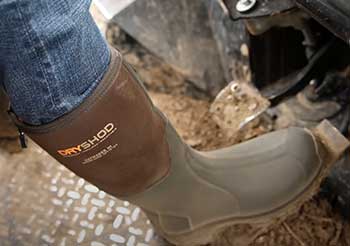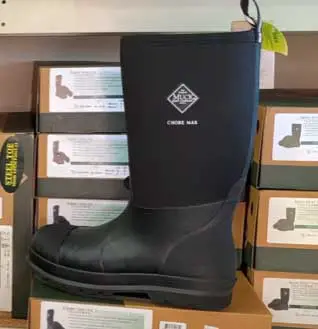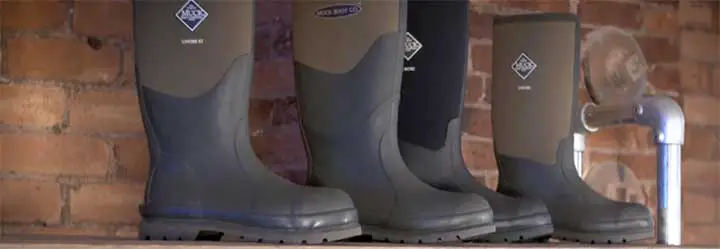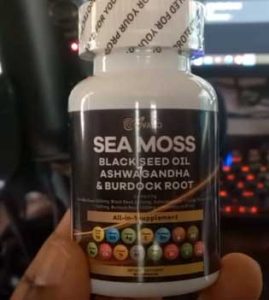When it comes to waterproof boots, Dryshod and Muck are two of the most popular brands on the market. Both offer durable, comfortable boots designed to keep your feet dry in wet conditions. But which brand truly comes out on top?
In this comprehensive guide, we’ll compare Dryshod and Muck boots across a variety of factors including warmth, traction, comfort, style, and pricing. Read on to see how these two waterproof boot brands stack up against each other so you can decide which is best for your needs and budget.
A Brief Comparison Table
| Feature | Dryshod | Muck |
| Warmth | Very warm thanks to insulation like Primaloft and Thinsulate | Warm but less insulation than Dryshod |
| Traction | Excellent grip from rugged rubber outsoles | Good traction from lugged rubber soles |
| Waterproofness | 100% waterproof construction | Also 100% waterproof |
| Comfort | Very comfortable thanks to cushioned insoles | Fairly comfortable but not as cushioned as Dryshod |
| Durability | Extremely durable and long-lasting | Durable but not quite as rugged as Dryshod |
| Style | More stylish look with leather accents | Very utilitarian style |
| Pricing | mid to high price range | affordable pricing |
Key Differences Between Dryshod And Muck Boots
Now let’s dive into the details on how Dryshod and Muck boots match up in key performance areas.
- Warmth

One of the main reasons people buy winter boots is to keep their feet warm in cold temperatures.
Both Dryshod and Muck offer insulation to retain heat, but Dryshod tends to use more advanced insulating materials that trap more body heat.
Dryshod boots feature 200g Primaloft insulation or 400g Thinsulate.
These synthetic insulations are highly effective at retaining heat and keeping your feet warm down to -40 degrees Fahrenheit. Even the thinner Primaloft insulation used in some Dryshod boots provides excellent warmth.
Muck boots do contain insulation, but most models use lower density materials compared to Dryshod. The insulation isn’t quite as warm and may only keep your feet comfortable down to around freezing temperatures. If you live somewhere with very cold winters, Dryshod has the edge for warmth.
Winner: Dryshod
- Traction
Slipping and sliding on wet, icy, or muddy terrain can spell disaster. That’s why good traction and grip are key for waterproof winter boots. Both Muck and Dryshod boots stand up well in this category thanks to rugged rubber outsoles.
Dryshod boots feature thick, aggressively lugged Vibram outsoles that provide an almost unbeatable grip on uneven ground. The deep lugs combined with the soft rubber compound bite into surfaces for excellent traction.
Muck boots also have lugged outsoles, but they tend to be a bit shallower and stiffer than Dryshod’s. The grip is certainly good, but not phenomenal. When it comes to traction, Dryshod once again has a slight edge.
Winner: Dryshod
- Waterproofness

The main point of waterproof boots is keeping water out so your feet stay dry.
Both Muck and Dryshod boots deliver on this promise with completely sealed, waterproof constructions.
Dryshod uses waterproof leathers and membranes to block moisture.
Many styles also have gusseted tongues to prevent water from seeping in.
Similarly, Muck constructs their boots from waterproof synthetic rubbers like neoprene to keep water completely out.
When it comes to waterproof performance, Muck and Dryshod are evenly matched. Both will keep your feet dry in wet conditions.
Winner: Tie
- Comfort
In addition to warmth and waterproofness, you want your winter boots to be comfortable on your feet all day long. Here’s how Muck and Dryshod compare when it comes to comfort:
Dryshod boots contain molded EVA midsoles or memory foam footbeds that provide pillowy cushioning with each step. Many styles also have faux fur lining for a soft, cozy feel. Overall, Dryshod boots are very pleasantly comfortable right out of the box.
Muck boots aren’t uncomfortable, but they aren’t quite as well-cushioned as Dryshod designs. The neoprene material has some shock absorbing properties, but there isn’t as much underfoot softness. Muck boots get the job done for comfort but aren’t luxuriously cushioned like some Dryshods.
Winner: Dryshod
- Durability
The longer your waterproof boots last, the more value you get from your purchase. Both Muck and Dryshod build their boots tough, but Dryshod edges out Muck when it comes to long-term durability.
The leathers and rugged Vibram outsoles used in Dryshod boots stand up to years of wear and tear. You can count on Dryshod designs easily lasting 5+ years with proper care. They really are built like tanks.
Muck boots are also made from quality materials, but thinner synthetic rubbers may be more prone to punctures or tears over time. The overall construction isn’t quite as heavy-duty as Dryshod. While Muck boots are long-lasting, Dryshod ultimately wins for durability.
Winner: Dryshod
- Style

Beyond function, style and aesthetics may play a role in which brand of boot you pick.
Here’s how Muck and Dryshod boots compare looks-wise:
Dryshod boots have a more refined, outdoorsy style thanks to nice leather uppers and accents on many designs.
The leather pops against the rubber bottoms for a more sophisticated look compared to plain rubber boots.
Dryshod makes boots you’d be happy to wear around town.
Muck has a very utilitarian, industrial look focused on function over fashion. The all-rubber construction certainly looks rugged but not very stylish. Those wanting boots that look good with jeans may prefer Dryshod’s leather-accented designs.
Winner: Dryshod
- Pricing
Last but not least, price plays a key role when choosing between boot brands. Muck boots are generally more budget-friendly, while Dryshod commands higher prices:
- Muck boots cost $80-$150 per pair on average.
- Dryshod boots run from $150-$350+ per pair.
The higher prices of Dryshod boots reflect their premium materials and construction. However, Muck still delivers good performance at a more wallet-friendly cost. If you’re on a tight budget, Muck is likely the better value.
Winner: Muck
Which One To Pick?

When we tally up the scores, Dryshod emerges as the overall winner when compared head to head with Muck boots. Dryshod swept most categories thanks to excellent warmth, traction, comfort, durability, and style. Muck does still win for affordability and matches Dryshod’s waterproofness.
Here’s a quick summary of how the brands compared:
- Dryshod has better warmth and insulation
- Dryshod provides superior traction
- Both are 100% waterproof
- Dryshod has more underfoot comfort
- Dryshod edges out Muck in durability
- Dryshod boots look more stylish
- Muck is the budget winner
In the end, Dryshod boots beat out Muck across more categories and take the crown as the best overall waterproof winter boot. Their cozy insulation, rugged traction, plush comfort, and handsome leather styling make them a fantastic choice for cold, wet weather.
That said, Muck boots remain an excellent affordable option. If you want reliable waterproof boots without breaking the bank, Muck is a great choice.
We hope this comprehensive comparison helps you decide whether Dryshod or Muck better meets your needs and preferences for waterproof winter footwear. Both brands make quality boots, but Dryshod stands out as the premium top pick. Stay warm and dry this winter in a pair of durable Dryshod or Muck boots!
Also Read: Comparison of Muck and Bogs Boots.
Frequently Asked Questions (FAQ)
Yes, Dryshod boots are extremely high quality and among the best available. They stand out for their superior warmth, traction, comfort, and durability compared to competitors. Dryshod uses premium leathers, advanced insulation, and rugged outsoles to create boots that excel in cold, wet conditions. Their excellent construction and materials make them well worth the investment.
While Muck makes good quality boots, some brands like Dryshod are considered better overall. Dryshod beats out Muck when it comes to insulation, traction, long-term durability, comfort, and style. Dryshod uses thicker insulation and aggressively lugged outsoles for better warmth and grip. Their leather-accented styles are also more stylish than the utilitarian Muck. If you want an upgrade over Muck, Dryshod is an excellent option.
Yes, one of Dryshod’s standout features is their exceptional warmth. They use premium Primaloft and Thinsulate insulation at higher densities than many competitors, allowing their boots to retain heat even in frigid conditions down to -40 degrees Fahrenheit. Even lighter insulated Dryshod designs provide good warmth for most winter activities. Warmth is certainly one of Dryshod’s strengths.
It’s not recommended to put Muck boots in the dryer as the heat can damage the rubber and cause it to become misshapen. Air drying is the safest approach for Muck boots. Remove the insoles and stuff the insides with newspaper to help absorb moisture. Allow them to fully air dry before wearing again. Avoid direct heat which can degrade the integrity of the rubber over time.
Wrapping Up
When comparing Dryshod and Muck boots, Dryshod emerges as the overall winner for their superior warmth, traction, comfort, durability, and style. However, Muck remains a great budget option for shoppers looking for affordable waterproof boots.
Use this guide to help decide if the premium quality of Dryshod is worth the higher prices over good-value Muck boots. Either option will serve you well through winter, but analyze your needs to pick the brand that’s right for you.
We hope this straightforward comparison helps you invest in winter boots that meet your unique needs and keep you moving through the cold, wet months in comfort.




Dryshod boots are crap, I only wore mine for gardening and they lasted 1 season and cracked amd leaked the nest